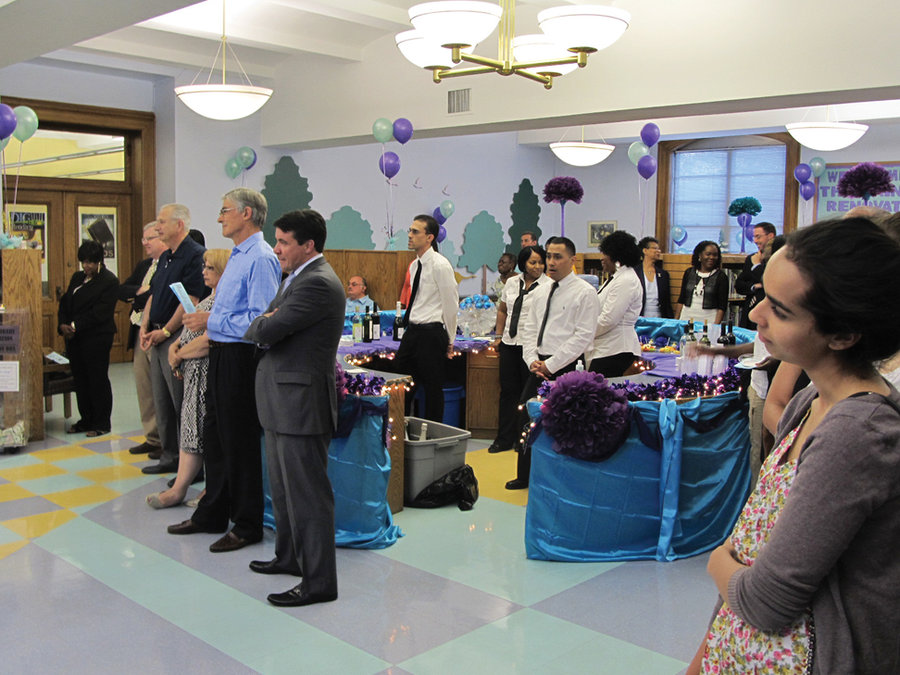Walking into the main branch of the 113-year-old Jersey City Library is like walking back in time. Unfortunately, part of that past is one in which fluorescent lights and 1960s-era fixtures were commonplace. Another part of that past includes the lack of central air conditioning, leaky windows, an elevator slightly larger than an old fashioned phone booth, and problems for the disabled in accessing key parts of the building.
Library and city officials and others who support the library’s efforts gathered on June 24 to kick off a campaign to modernize the library but still keep its historic distinction.
The city has appropriated $5 million for the first phase that began last September, to pay for the construction of a new elevator shaft and elevator as well as a new assessable entrance for the disabled.
The library hopes to raise another $3 million to do facility improvements for the second phase of the project by using a “crowd-funding” campaign to raise the money. This was the brain-child of Library Foundation trustee Alma Burnett, who hoped this would encourage people who care about the library to help fund refurbishing and retrofitting the historic Main Library.
“We want to keep the character of the original, but bring it into the 21st century.” – Helena Ruman
____________
Major donors will be acknowledged with their names on a donation tree in the Main Library lobby.
A historic place
While the building does not have federal historic designation, it is located in the historic district of Jersey City. The Main Library is an architectural example of the Italian Renaissance tradition. The first sight that greets visitors to the main lobby is a Tiffany glass window. The main branch opened its doors for the first time in January 1901. It was expanded in 1927, and while significant technological improvements were made from the 1970s on, portions of the building have suffered from age, such as an attached nine story stack area that had to be demolished in 2006.
The Main Library offers a wide array of educational and cultural programming. It is home to the Vincenzo Domenico Bonetti II Room; a children’s department; the Biblioteca Criolla, the only department within New Jersey’s public library systems dedicated solely to printed and recorded Spanish works and Hispanic cultures; and the New Jersey Room, a recognized repository of historic documents and maps of Jersey City, Hudson County and New Jersey.
Part of the upgrade will be to make the library’s resources available to all it patrons.
“For too many years, retrofitting the Main Library for disabled compliance was put on the back burner,” said Library Director Priscilla Gardner, who also serves as the Library Foundation’s executive director. “Now is the time to make sure this building of over 100 years will stand the test of time and welcome the next century of library patrons, no matter what one’s physical ability.”
A tour of the library
To help people better understand the historic treasure the city has in the Main Library and to show some of the improvements that need to be made, architect Helena Ruman led a tour through the four floors of the library.
Ruman said restoration of the interior of the building will be kept in line with the original concept.
“We want to keep the character of the original, but bring it into the 21st century,” she said.
While designed to upgrade elements that are part of the historic backdrop of the building, Ruman said the project also hopes to introduce amenities that would be required in any modern library. This is a nuts and bolts upgrade that deals with things from carpet to woodwork, but all done with the historic aesthetic in mind – including a new heating and air-conditioning system to replace the piecemeal approach the library has had to undertake in the past.
The project also includes new roofing, repairs to the ornamental copper, and reconstruction of the penthouse. While the copper looks great from a distance, she said, when you get close up, there are holes in it that you can stick a fist through.
She said there are places in the building where wires are exposed, so repairs are needed. Plumbing improvements are also needed, and rest rooms need to meet the standards of the Americans with Disability Act.
Some of the lighting, such as the fluorescent fixtures, is not only out of character with the historic elements of the interior but do not meet modern energy efficiency requirements, she said.
The new elevator will be installed at street level, and the existing elevator – a throwback to the era of hand-operated elevators – will become an exhibit and kept stationary on the first floor.
The not-so-quaintly historic bathrooms on the first floor will be modernized and two new public bathrooms will be installed on the fourth floor.
The Tiffany window which overlooks the first few steps rising from the first floor will be restored and backlighting will be installed.
The sprinkler system in the building will be upgraded as well.
The Jersey Room – which is one of the jewels for researchers – will likely get climate-controlled stacks in order to preserve its archive of significant documents.
Freeholder Bill O’Dea, who was among the dignitaries that came to help kick off the fundraising, said he hopes to also bring money to the project from the Hudson County Open Space Trust Fund, which is designed in part to help preserve and upgrade historic spaces in Hudson County.
Al Sullivan may be reached at asullivan@hudsonreporter.com.
